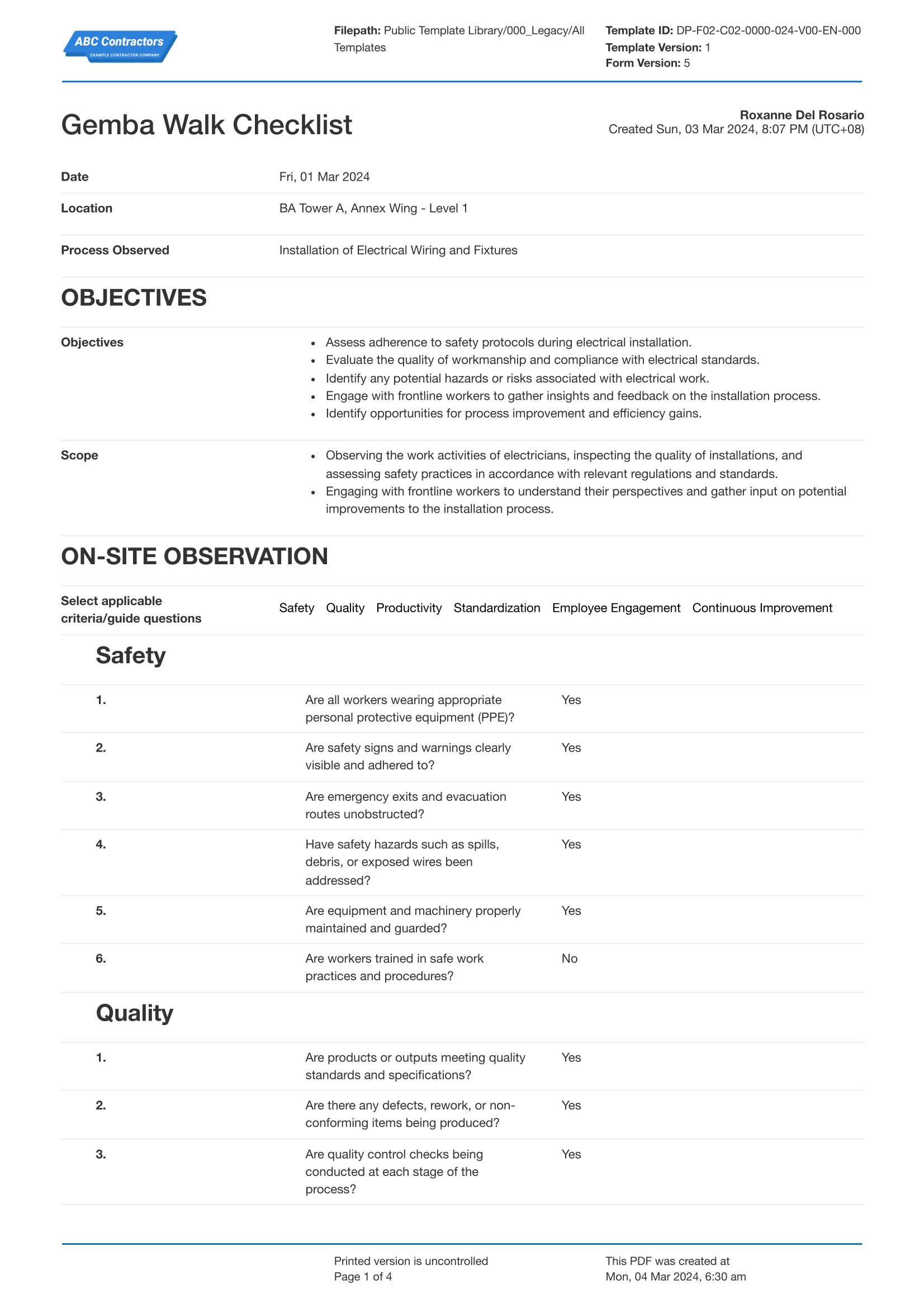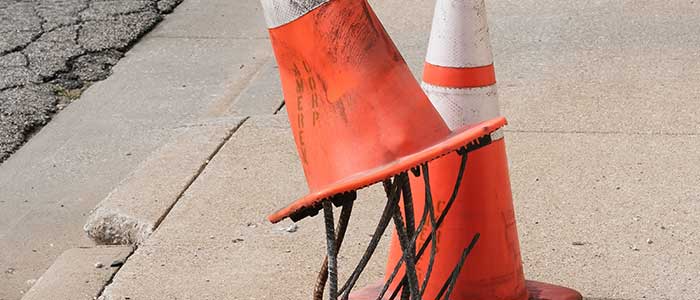Dashpivot Article – Purpose of Gemba Walk
Purpose of Gemba Walk
In this article, we'll properly explain the purpose of a Gemba Walk, and provide you with a number of details and resources to ensure you can also run high quality gemba walks.

In the fast-paced construction industry, which contributes $360 billion to the economy every year, a new way of managing is emerging. However, a 2023 KPMG survey of the Construction Industry shows that 87% of project managers are experiencing project performance, delays and cost issues.
Gemba Walks, used by Japanese industry giants can help with these issues. Workplace incidents cost businesses $61.8 billion a year, and construction is one of the top 3 most dangerous industries. Direct observation and engagement through Gemba Walks can prevent workplace accidents.
What is a Gemba Walk: Meaning and History
During post-war Japan, the leaders of Toyota found something quite simple. Instead of sitting in their offices reading reports, they went to where the action was happening. It’s called ‘Gemba’, Japanese for ‘the real place’ and it’s all about getting leaders’ hands dirty, talking to workers and seeing the problems first-hand.
This human approach spread all over the world and showed that sometimes, the best way to lead is not through spreadsheets and meetings - it’s just by walking around and listening to your people.
A Gemba walk is a simple, yet very powerful way to gather insights, understand processes and identify opportunities for improvement. A Gemba Walk is aimed at specific goals, like improving customer service, safety or productivity. They aim to find the issues, reduce waste and engage employees who deliver value.
What is the Purpose of a Gemba Walk?
A Gemba Walk is a journey that brings the managers into the heart of the operation, onto the ground where work happens. It could be a building full of controlled chaos, behind the office doors or a chaotic work environment Walks bring and create beautifully meaningful connections between leadership and reality at the front lines.
What is the Purpose of a Gemba Walk for industrial companies?
Here at Sitemate, we build best-in-class software for industrial style companies (construction, manufacturing, oil and gas etc.), so we will focus much of this article on these built world sectors.
These industries are where the purpose of a Gemba Walk really makes sense anyway, as they have a field-based component, meaning management or relevant supervisors can get out into the field and perform a Gemba Walk.
From Factory Floors to Construction Sites
While Gemba Walks originated in manufacturing, they have spread far beyond the factory floor. Today’s forward-thinking leaders are applying this powerful practice across all work settings, recognising that true understanding comes from direct observation and engagement, not spreadsheets and reports.
Not Your Standard Site Inspection
This has nothing to do with clipboard-toting managers, running through scheduled rounds of observations. It’s all about really wearing the working shoes of subordinates, trying to grasp all daily frustrations and, essentially, feeling things as done from their point of view. What management gains thereby can never emerge through discussion inside meeting rooms.
Why Construction Sites Need Gemba Walks
Gemba Walks take on a special meaning in the world of fast-paced construction and the built world. A construction site is a living ecosystem with many moving parts that need to be coordinated into one big process. Gemba Walks by managers would mean getting up close and personal with the actual physical challenges their teams face and the safety areas they worry about on a daily basis, as well as the flow of materials, equipment and people through the site.
The real value of Gemba Walks is in the change because it combines the observations with worker feedback to make changes that matter. Ground-level insights mean change isn’t about theory but solutions to real problems the workers face.
Benefits of Gemba Walks
When done right, the benefits of Gemba walks go beyond the construction industry to many other fields. Here are some of the benefits it can potentially offer:
Behind the Purpose of a Gemba Walk - The leader gets a feel of the daily operations
Regularly, leaders who walk around their shops or work areas get more than data - they get a feel of their daily operations. Through directly working with them in the daily operations, they will see bottlenecks and inefficiencies that are not visible from a distance, not just sitting in an enclosed cubicle.
Behind the Purpose of a Gemba Walk - Leaders get a 360-degree view of their business
Gemba Walks enable leaders to see how different departments interact and impact each other; improving services and products that in turn impact customer satisfaction.
Behind the Purpose of a Gemba Walk - Leaders get to know the people and their processes.
The key part of every Gemba Walk is interacting with employees as interactions are not just observation, but also engaging with teams to get feedback. Direct communication helps leaders understand what’s working and what’s not on the ground.
A third benefit of doing Gemba walks is building relationships between management and frontline workers. While doing the walks, management learns from employees and shows them appreciation and value for their expertise. When respect is established, trust comes in, as well as better communication, enabling employees to be empowered to solve future problems independently.
How to do a Gemba Walk so it Achieves its Purpose
While Gemba walks benefit any type of industry, the hard part is the implementation stage. The benefits can only be maximised when a Gemba walk is done effectively. We have combined the following useful tips for you to do Gemba walks the right way:
- Plan your Gemba Walk:
Just like going into war, swords must be sharpened as it is preparing for the Gemba Walk. Before anything else, a clear goal or purpose for each walk must be set: sales process, time waste and safety. You don’t have to cover everything in one step and you can sometimes set up an objective for the walk: productivity or safety; keep checking the checklist of specific items to check, but don’t forget that the checklist is meant to point out factors you didn’t think of. - Frequency: How often Gemba Walks are done:
How often you do Gemba Walks depends on your industry, type of work, size of your organisation and your goals and objectives. For example, in a shop floor operating an automobile manufacturing plant, supervisors may do daily Gemba Walks across different areas of the shop floor to keep a regular check on operations. Ultimately, it’s up to the leader to decide on how often to do Gemba Walks. - Inform your workers:
As a general rule of thumb, inform your frontline workers about the Gemba Walk beforehand to avoid misunderstandings or job security concerns. Inform them when the walk will take place and the objectives behind it. Educate the team members that the goal is to improve processes and make their jobs easier, and that will make them more comfortable and open during the walk. - Follow your value stream:
Understand the flow of value through your organisation—what do you produce and how? Start where the value creation begins, like the start of a production line or the intake of a new job and follow the process through to the end. That path will reveal many opportunities for improvement, especially at handoff points between teams or where bottlenecks occur. - Document and note:
Take detailed notes during the Gemba Walk and don’t just rely on your memory. Documenting helps you to stay focused and prevent premature conclusions and these notes are for later reflection and planning without bias. - Review and share:
After the walk, compile your observations into action items and discuss them with your team. Sharing your findings and asking for input shows you respect their experience and helps to refine the improvements. This follow-up is for transparency and to show Gemba Walks is a team effort, not just for compliance. - Consistency is key in your Gemba Walks, so each walk must be focused on and observations must be comparable across different sessions. As a result, a standardised Gemba Walk checklist for each session comes to life.
Here is an Gemba Walk below to help you get started, and more Gemba Walk Examples can be found here.

Use and customise this digital Gemba Walk checklist template for free
Simplify and improve with ease using a smart Gemba Walk
A dedicated Gemba Walk app will help make your team get better at Gemba Walk. Doing Gemba Walks on-site has never been easier with your mobile or tablet and sync the data back to the office once submitted.
As an extra feature, you can also take photos through the app, attach them to your Gemba Walk documents and use photo markup to highlight hazards or areas for improvement for transparency. Setting up hassle-free automated workflows to make planning, doing and reviewing Gemba Walks is better with our app.
Your Next Step: Is Gemba Walk Worth For You?
As we have seen in this article, Gemba Walks are more than just another management tool; they are a fundamental shift in how leaders engage with their teams and operations. As Australian construction projects are concerned about performance issues, the simple act of being present and observant is revolutionary.
Whether you have a small construction site or multiple projects across Australia, the journey of a thousand miles starts with one step. Start your Gemba Walk journey today, with no complicated strategy or using a smart solution like our Gemba App and remember to just walk, observe and listen. The bonus part is you can follow in the footprints of industry leaders' success and create more efficient, safer and more connected construction industry.
So, it’s not when will you implement Gemba Walks, but when will you take your first step.

Snag list template
Don't let snags get in the way of project completion.

Non-conformance report (NCR) template
Document those painful non conformances with this powerful template.

Defect Report template
Manage and rectify those inevitable defects with ease.




